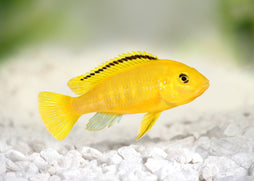Description
Neolamprologus “Sunflower” is a striking, lesser-known variant of the Neolamprologus genus, believed to originate from the southern regions of Lake Tanganyika. Named for its warm golden-yellow coloration and bold attitude, this species combines aesthetic appeal with fascinating behavioural traits. Like many Neolamprologus species, it exhibits strong territorial instincts and intricate breeding behaviours, making it well-suited for dedicated Tanganyikan biotope aquariums.
Features of Neolamprologus “Sunflower”
• Reaches 8–10 cm in length as a fully grown adult
• Vivid yellow to gold body with subtle blue or white highlights on fins
• Sexually monomorphic, though males are generally larger with sharper finnage
• Highly territorial, especially during breeding periods
• Forms monogamous pairs and defends small territories around caves or rockwork
• Lifespan typically ranges from 8 to 10 years
The best aquarium size for Neolamprologus “Sunflower”
A minimum tank size of 120 litres is recommended for a pair. For a community or species group, 200 litres or more is preferred. Horizontal space is crucial for territory division and reducing interspecies aggression.
Tank Mate Compatibility for Neolamprologus “Sunflower”
• Julidochromis ornatus
• Altolamprologus compressiceps
• Cyprichromis leptosoma
• Synodontis lucipinnis
• Neolamprologus caudopunctatus
Diet for Neolamprologus “Sunflower”
This species is omnivorous with a preference for protein-rich foods. Offer high-quality cichlid pellets, supplemented with frozen or live brine shrimp, mysis, and finely chopped krill. Occasional spirulina-based foods or algae wafers can be added for dietary variety. Avoid overfeeding and maintain strict portion control to preserve water quality.
Aquarium Setup Neolamprologus “Sunflower”
Aquarium Filtration
Use a high-efficiency canister or sponge filter that supports both mechanical and biological filtration. Gentle flow is preferred. Maintain parameters with pH between 8.0–9.0, and general hardness around 10–18 dGH.
Aquarium Plants
Plants are not essential but can be used decoratively. Choose hardy species like Anubias, Vallisneria, or Java fern, which can tolerate hard, alkaline water and do not require substrate planting.
Aquarium Lighting
Moderate lighting works well to showcase the golden tones without causing stress. Natural-spectrum LEDs enhance the fish’s colour while keeping algae growth under control.
Aquarium Heating
Maintain water temperature between 24–26 °C using a reliable heater with a thermostat. Ensure temperature stability, especially in smaller tanks.
Aquarium Substrate
A sandy substrate is ideal, allowing natural digging behaviour and supporting rock stability. Avoid sharp or coarse gravel that can damage fins.
Aquarium Decorations
Use plenty of rockwork to create caves and visual barriers. Territorial boundaries are essential to reduce aggression. Slate, limestone, or lava rock works well. Ensure all structures are stable and secure against collapse from digging or shifting.











